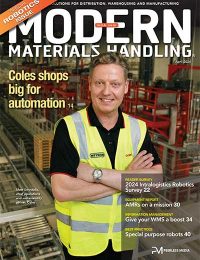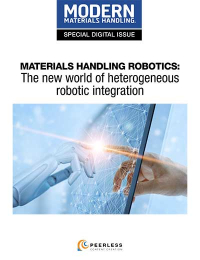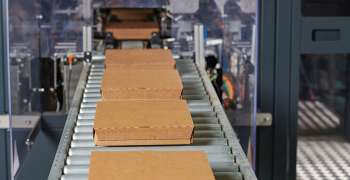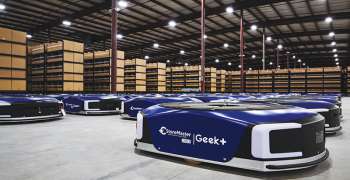Walk a mile in another’s shoes
Latest Material Handling News
Two voices of reason on pallet materials 60 Seconds with Bob Trebilcock, outgoing executive editor, Modern Materials Handling The reBound Podcast: How Pitney-Bowes is innovating with autonomous vehicles. Packaging Corner: Be open to change 60 Seconds with Robert Martichenko of American Logistics Aid Network More BlogsEarlier this week, I wrote about Sue Kutz, a South Carolina mom who is working with the Don Frazier Center to deliver food to children who don’t have enough to eat on the weekends. It was an example of how materials handling is making a difference in the lives of the less fortunate.
I recently came across Samaritan’s Feet International, a Charlotte, North Carolina-based charity that is using supply chain management software to make a difference in the lives of individuals without shoes. I learned about the group from RedPrairie, which donated its on-demand WMS software to the organization.
The organization’s mission is simple. “We deliver athletic shoes to the most impoverished people in the world,” says Bruce Bodman,director of supply chain management. “As part of our program, we wash the feet of everyone who gets a pair of shoes. We’re trying to bring a message of hope to those who may feel forgotten.” Recipients include women and children in poor villages in Africa, Central and South America and the Caribbean and prisoners in Peru. Last year, Samaritan’s Feet delivered about 750,000 pairs of shoes worldwide.
Unlike some organizations, Samaritan’s Feet is not delivering used shoes. The organization manufactures its own brand of shoe in China. It also gets donations from retailers like Kmart, which donated a million pairs of shoes in 2009, and shoe makers like Converse and Fila. The organization even receives counterfeit shoes seized by Homeland Security. In addition to shoe makers and retailers, Samaritan’s Feet receives support from the NBA Going to be doing things with the NBA and college basketball. Bodman says you can expect to see basketball coaches working in barefeet this season on TNT in an effort to bring attention to the issue of shoelessness around the world.
Founded 7 years ago, the organization has roots in our world. In a previous life, Bodman ran distribution centers for Pic ‘N’ Pay Shoes. Emmanuel “Manny” Ohonme, the founder, has a masters degree in supply chain management. Ohonme understood the difference a pair of shoes can make in someone’s life from personal experience. He received his first pair of shoes at age 9 from a missionary in his native Lagos, Nigeria. Ohonme subsequently learned to play basketball well enough to earn a college scholarship in the US. After earning his masters degree, Ohonme worked for RedPrairie before founding his ministry.
A foundation in supply chain management has proved to be a requirement to a logistically-challenging operation. “When I worked for Pic ‘N’ Pay, we had over 700 stores,” says Bodman. “This is ten times more complicated than what I did there, without a doubt.”
In Charlotte, the organization operates a 14,000 sq ft distribution center and utilizes another 50,000 sq ft of donated space nearby plus about 15,000 sq ft with a 3PL. There are other warehouses across the US in places like Washington, D.C., Greencastle, Pa., Indianapolis, and San Bernadino, where there is 60,000 sq ft of donated space. Then, there are DC’s in Lima, Peru, Guyan, Mombassa, Cameroon and South Africa and Sao Paolo, to name just a few. On top of all that, Bodman manages delivery of shoes from factories in China.
“We have huge inventory management challenges,” says Bodman says. “If we manufacture the shoes, we know what we have and in what sizes. When we get donations, we have no idea what’s coming into us until we get them.” What’s more, he says, he has to manage customs requirements that may differ in every country where he ships. Sometimes, he has to report where a donor’s shoes were sent. Homeland Security, on the other hand, restricts where shoes can be sent. Peru requires him to account for every individual who receives shoes. “We have had to provide information on every one of the 21,000 inmates we’ve given shoes to. They audit us in our storage facility,” Bodman says.
That’s where the WMS from RedPrairie will come into play. Bodman expects to use the system to track the organization’s inventory of shoes on a global basis. He went with an on-demand version of the software because it does not require him to install an infrastructure in donated facilities. “We are using donated space, which means that could change at any time,” Bodman says. “I can’t afford to invest in an infrastructure.”
To get things off the ground, the solution has been installed in San Bernadino and Charlotte, and was introduced in Peru, although it is not yet fully-functional. “With global visibility, I’m going to know what I have, where it’s located and in what sizes,” he says. “That’s going to allow me to do the right shipments, often on a last minute basis.”
You can learn more about the organization on the website ([url=http://www.samaritansfeet.com]http://www.samaritansfeet.com[/url]). You can make a $10 donation by texting the keyword shoes to #85944.

Article Topics
Blogs News & Resources
Two voices of reason on pallet materials 60 Seconds with Bob Trebilcock, outgoing executive editor, Modern Materials Handling The reBound Podcast: How Pitney-Bowes is innovating with autonomous vehicles. Packaging Corner: Be open to change 60 Seconds with Robert Martichenko of American Logistics Aid Network The reBound Podcast: Looking for talent in all the right places: How Essendant is revolutionizing recruitment The reBound Podcast: Innovation in the 3PL supply chain More BlogsLatest in Materials Handling
NetLogistik partners with Vuzix subsidiary Moviynt to offer mobility solutions for warehouses Materials Handling Robotics: The new world of heterogeneous robotic integration Lucas Watson appointed CSO for Körber’s Parcel Logistics business in North America Hyster recognizes Dealers of Distinction for 2023 Carolina Handling names Joe Perkins as COO C-suite Interview with Keith Moore, CEO, AutoScheduler.AI: MODEX was a meeting place for innovation Walmart deploying autonomous lift trucks at four of its high-tech DCs More Materials HandlingAbout the Author
Subscribe to Materials Handling Magazine

Find out what the world's most innovative companies are doing to improve productivity in their plants and distribution centers.
Start your FREE subscription today.
April 2024 Modern Materials Handling

Latest Resources










